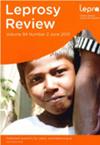Knowledge and attitudes on leprosy of healthcare workers in a tertiary government hospital in the Philippines
IF 0.8
4区 医学
Q4 DERMATOLOGY
引用次数: 1
Abstract
SummaryBackground/Objectives The drivers of stigma may vary from one society or country to another; thus, it is necessary to identify these drivers so that stigma elimination programs would be locally relevant. This study aimed to determine the current knowledge and attitudes on leprosy of healthcare workers in a tertiary government hospitalinthePhilippineswhichwillserveasthebasisforourfutureleprosyawarenesscampaigns. Methods We conducted a descriptive cross-sectional study among 265 healthcare workers in Rizal Medical Center (RMC), Philippines from January to March 2020 using a self-administered questionnaire. Descriptive statistics were used to describe the demographics and study variables. Results A majority had high (36.2%) or medium (35.5%) knowledge on leprosy. A majority (62.3%) had positive attitudes towards leprosy. However, only 18.5% knew that leprosy is transmitted through inhalation and a majority thought that it is transmitted either through body fluids and secretions (52.8%) or open wounds (27.5%). Only about half knew that a patient on treatment can no longer transmit the disease and does not need to be isolated, and that a patient who has completed treatment but still exhibits manifestations of the disease can no longer transmit the disease. majority high or medium knowledge leprosy and a positive attitude towards leprosy, identified misconceptions knowledge gaps centered on its mode of transmission and transmissibility which can lead to inappropriate fear of acquiring the disease from patients.菲律宾一家三级政府医院医护人员对麻风病的认识和态度
背景/目标污名化的驱动因素可能因社会或国家而异;因此,有必要确定这些驱动因素,以便消除污名化计划与当地相关。这项研究旨在确定菲律宾一家三级政府医院的医护人员对麻风病的当前知识和态度,该医院将为我们未来的麻风防治运动提供基础。方法我们于2020年1月至3月在菲律宾里扎尔医疗中心(RMC)的265名医护人员中进行了一项描述性横断面研究,使用自行问卷。描述性统计用于描述人口统计和研究变量。结果多数患者对麻风病有较高(36.2%)或中等(35.5%)的认识。大多数人(62.3%)对麻风病持积极态度。然而,只有18.5%的人知道麻风病是通过吸入传播的,大多数人认为它是通过体液和分泌物传播的(52.8%)或开放性伤口传播的(27.5%)。只有大约一半的人知道接受治疗的患者不能再传播这种疾病,不需要隔离,并且已经完成治疗但仍表现出疾病表现的患者不能再传播疾病。大多数人对麻风病有较高或中等的认识,对麻风病学持积极态度,发现了以其传播方式和传播性为中心的误解和知识差距,这可能导致对从患者那里获得疾病的不适当恐惧。
本文章由计算机程序翻译,如有差异,请以英文原文为准。
求助全文
约1分钟内获得全文
求助全文
来源期刊

Leprosy review
医学-病理学
CiteScore
1.10
自引率
16.70%
发文量
35
审稿时长
>12 weeks
期刊介绍:
Leprosy Review is an Open Access peer reviewed journal including original papers on all aspects of leprosy. Topics published include research into the medical, physical and social aspects of leprosy and information relevant to leprosy control. We publish original research, short reports, case studies and reviews. The vision of the journal is to improve the management and control of leprosy and its consequences, by publishing relevant research and sharing experiences and best practices.
 求助内容:
求助内容: 应助结果提醒方式:
应助结果提醒方式:


